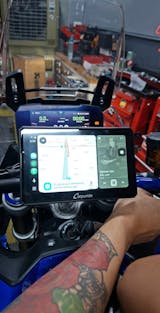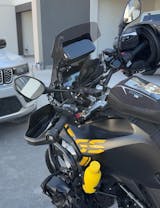Choosing the right motorcycle helmet is crucial for your safety and comfort on the road. In the U.S., motorcyclists face a crash fatality rate 29 times higher than car drivers, highlighting the importance of a properly fitting helmet. This guide will help you find the perfect fit, understand helmet sizing, and ensure you're protected with the right gear for safe and enjoyable riding.
How to Measure Your Head for the Perfect Fit?
Measuring your head is easy:
-
Get a flexible tape measure.
-
Wrap the tape measure around your head—about an inch above your eyebrows and around the widest part of the back of your head.
-
Record the measurement in inches or centimeters.
-
Refer to the manufacturer’s size chart to find the corresponding helmet size.
-
Try on the helmet to ensure a snug but comfortable fit.
Understanding Helmet Size Charts
Below are charts for adults and youth, organized by gender and age group for easy reference.
| Gender | Helmet Size | Head Circumference (inches) | Head Circumference (cm) |
| Men | XS | 21.2 - 21.7 | 54 - 55 |
| Men | S | 21.8 - 22.3 | 56 - 57 |
| Men | M | 22.4 - 22.8 | 58 - 59 |
| Men | L | 22.9 - 23.4 | 60 - 61 |
| Women | XS | 20.5 - 21.0 | 52 - 53 |
| Women | S | 21.1 - 21.5 | 54 - 55 |
| Women | M | 21.6 - 22.0 | 56 - 57 |
| Women | L | 22.1 - 22.5 | 58 - 59 |
|
Gender |
Helmet Size |
Head Circumference (inches) |
Head Circumference (cm) |
Age |
|
Boys |
S |
19.7 - 20.1 |
50 - 51 |
16-Oct |
|
Boys |
M |
20.2 - 20.5 |
52 - 53 |
16-Oct |
|
Girls |
S |
19.5 - 19.9 |
49 - 50 |
16-Oct |
|
Girls |
M |
20.0 - 20.4 |
51 - 52 |
16-Oct |
How to Choose the Right Helmet Shape for Your Head?
Choosing the correct shape helps prevent pressure points, ensuring comfort and better protection while riding. Here's some ways to determine.
- Helmet shapes: The helmet shapes generally fall into three categories, round, intermediate oval, and long oval.
- Round shape: If your head is almost equal in width and length, you have a round shape.
- Intermediate oval shape: If your head is slightly longer from front to back, it’s likely intermediate oval, which is the most common shape in the U.S.
- Long oval shape: If your head is significantly longer from front to back, you’ll need a long oval helmet.
Different Types of Motorcycle Helmets and Their Fit
Motorcycle helmets come in several styles, each offering a different balance of protection, comfort, and fit.
Full-face Helmets
Full-face helmets provide the most protection, covering your entire head, including your face and chin. They are ideal for safety, especially at high speeds. While they are well-ventilated, they can feel warmer in hot weather. The fit is snug and secure, reducing wind noise and offering complete coverage.
Modular Helmets
Modular helmets offer good protection similar to full-face helmets but with a flip-up chin bar for flexibility. This makes them slightly less protective when the chin bar is up. They are comfortable for varied conditions and fit securely, though they tend to feel bulkier due to the hinge mechanism.
Open-face Helmets
Open-face helmets protect the top and sides of your head but leave your face exposed, offering less protection. These helmets are very comfortable, providing excellent airflow, making them great for city rides. They fit snugly on the top and sides but allow more wind and noise since the face is uncovered.
Half Helmets
Half helmets give the least protection, covering only the top of your head. They are lightweight and provide maximum ventilation, making them comfortable for short trips or hot weather. However, they don’t fit as securely as other helmets and offer little noise reduction or impact protection beyond the top of your head.
Common Sizing Mistakes and How to Avoid Them
For motorcycle newbies, they often make some mistakes that affect safety:
Choosing a helmet that’s too large
A loose helmet may feel comfortable initially but becomes less protective as the padding compresses over time.
Ignoring head shape
Just matching the size isn’t enough; you need to find a helmet that fits your head shape to avoid pressure points.
Not trying the helmet on properly
Always wear the helmet for a few minutes to ensure it fits snugly without causing discomfort.
Overlooking brand-specific sizing
Sizes can vary between brands, so don’t assume your size will be the same across different helmet manufacturers.
Failing to check fit after break-in
Helmets loosen slightly with wear, so ensure it’s tight enough initially to accommodate this.
Why Helmet Fit Matters for Safety and Comfort?
A snug helmet stays in place during an accident, providing optimal protection, while a loose one may shift or come off, reducing safety. For additional motorcycle safety tips, always ensure a well-fitting helmet to prevent headaches or pressure points, allowing you to focus on the road without distraction.Motorcycle Helmet Care and Maintenance Tips
Proper care extends the life of your helmet and ensures it continues to protect you.-
Clean the exterior with mild soap and water, avoiding harsh chemicals that can damage the shell.
-
Wash the interior padding by hand to remove sweat and bacteria, and allow it to air dry.
-
Store in a cool, dry place away from direct sunlight to prevent material degradation.
-
Inspect regularly for cracks, dents, or signs of wear, and replace the helmet if any damage is found.
-
Replace after impacts, even if no visible damage is present, as internal integrity may be compromised.
-
Avoid dropping your helmet as even minor impacts can reduce its effectiveness over time.
Motorcycle Safety Driving Tips
Aside from wearing a properly fitted helmet, there are several key factors to ensure safe motorcycle driving:-
Maintain a safe distance from other vehicles to allow for proper reaction time.
-
Regularly check your motorcycle’s condition, including tire pressure, brakes, and lights.
-
Be cautious at intersections, as many motorcycle accidents happen there.
-
Use both brakes smoothly to avoid skidding during sudden stops.
-
Always signal before changing lanes to alert other drivers of your movements.
-
Stay visible by wearing bright or reflective gear, especially in low-light or night conditions.
-
Avoid distractions by using hands-free systems, like CarPlay for motorcycles, which allows you to access navigation and calls without losing focus on the road.
-
Stay focused on the road and your surroundings with the help of a motorcycle display, which makes it easier to monitor speed, navigation, and other essential ride details, ensuring maximum safety while riding.
Conclusion
Finding the right helmet size and ensuring a proper fit are essential steps in maximizing your safety and comfort on the road. For even safer, more convenient rides, consider adding motorcycle CarPlay to your setup. Carpuride’s Apple CarPlay for motorcycles provides hands-free access to navigation and calls, keeping your focus on the road where it belongs. Explore Carpuride’s Motorcycle CarPlay today!
FAQs
1. How often should I replace my motorcycle helmet?
Most helmet manufacturers recommend replacing your helmet every 5 years, as the materials inside can degrade over time. However, you should replace it immediately if it's involved in an accident or shows any signs of damage, such as cracks or loose padding. Regular inspection helps ensure the helmet’s integrity for maximum protection.
2. What’s the best type of helmet for long-distance riding?
For long-distance rides, a full-face helmet is often the best choice. It offers superior protection, wind noise reduction, and comfort over extended periods. Full-face helmets typically have better ventilation and secure padding, making them ideal for longer trips by reducing fatigue and exposure to the elements.
3. Are there special helmets for hot or cold weather riding?
Yes, some helmets are designed specifically for different weather conditions. For hot weather, look for helmets with enhanced ventilation and moisture-wicking liners to keep you cool and dry. For cold weather, a helmet with a removable, insulated liner or a winter-ready design will help retain warmth. Additionally, consider a fog-resistant visor to improve visibility in varying temperatures.
4. Can I use a helmet with a different shape if I find my size?
It’s not advisable to use a helmet that doesn’t match your head shape, even if the size is correct. Wearing a helmet that doesn’t align with your head shape can cause pressure points, discomfort, and may even reduce the helmet's effectiveness in an accident. For the best fit, choose a helmet that matches both your size and head shape.
5. What’s the difference between modular and full-face helmets in terms of safety?
While both offer good protection, full-face helmets generally provide better safety due to their single-piece design, which protects your entire face and chin. Modular helmets have a flip-up feature that provides flexibility, but they are slightly less protective when the chin bar is up. They’re a great choice for riders who need to adjust frequently, but for maximum protection, full-face helmets are the safest option.















